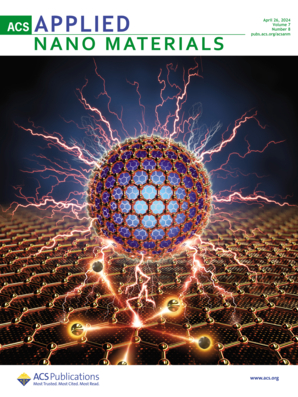利用纳米层光刻技术生成的混合质子基底实现无标记生物传感
IF 5.3
2区 材料科学
Q2 MATERIALS SCIENCE, MULTIDISCIPLINARY
引用次数: 0
摘要
空气/水界面涂层的快速发展跨越了多个领域。这些涂层具有覆盖面广、易于获得和经济高效等优点,在纳米表面工程中发挥着举足轻重的作用。实现二维周期性结构的传统方法,如电子束光刻法,面临着成本和复杂性的挑战。纳米层光刻技术利用胶体纳米粒子固有的自组装倾向,提供了另一种途径,具有简单、成本效益高以及与各种技术兼容的特点。纳米层光刻技术在金属模板涂层中的应用因其简便快捷而在等离子体学中大受欢迎。等离子体学与生物传感技术的融合使无标记检测具有前所未有的灵敏度,为医学、诊断学和环境监测等领域带来了革命性的变化。在无标记生物传感领域,实现均匀的大面积制造对于获得可靠的传感信号至关重要。检测低浓度分析物的光谱变化需要精确的响应曲线。要增强光与生物分子之间的相互作用,就必须建立一个强大且易于获取的局部电磁场。我们通过纳米球光刻技术引入了一种混合质子基底,将天线和孔径响应结合在一起。混合质子设计满足了高效无标记生物传感、均匀大规模制造、窄光谱响应和强局部电磁场等先决条件。混合质子基底有望通过集成天线和孔径响应来提高无标记生物传感能力,从而促进灵敏、稳健的生物传感应用。展示这些参数后,折射率灵敏度高达 553 nm/RIU。混合特性进一步促进了 0.5 纳克/毫升的无标记蛋白质 IgG 检测限。本文章由计算机程序翻译,如有差异,请以英文原文为准。

Label-free Biosensing Using Hybrid Plasmonic Substrates Generated via Nanosphere Lithography
The rapid advancement of air/water interface coatings transcends multiple domains. These coatings, valued for expansive coverage, facile acquisition, and economic efficiency, hold pivotal roles in nanosurface engineering. Conventional approaches to achieving 2D periodic structures, such as electron-beam lithography, suffer from cost and complexity challenges. Nanosphere lithography presents an alternative avenue by harnessing the inherent self-assembly propensity of colloidal nanoparticles and offers simplicity, cost-effectiveness, and compatibility with various techniques. The use of nanosphere lithography in coating metal templates gains traction in plasmonics because of its simplicity and speed. The fusion of plasmonics and biosensing enables label-free detection with unprecedented sensitivity, revolutionizing areas such as medicine, diagnostics, and environmental monitoring. In the realm of label-free biosensing, attaining uniform large-area fabrication is critical for robust sensing signals. Detecting spectral variations in low analyte concentrations necessitates a precise response profile. The creation of a potent and accessible local electromagnetic field is vital for enhancing light–biomolecule interactions. We introduce a hybrid plasmonic substrate via nanosphere lithography, combining antenna and aperture responses. The hybrid plasmonic design caters to the prerequisites of efficient label-free biosensing, uniform large-scale fabrication, narrow spectral response, and strong local electromagnetic fields. The hybrid plasmonic substrate promises to advance label-free biosensing capabilities by integrating antenna and aperture responses, facilitating sensitive and robust biosensing applications. Demonstrating these parameters resulted in a high refractive index sensitivity of up to 553 nm/RIU. The hybrid nature further facilitated an impressive detection limit of 0.5 ng/mL for label-free protein IgG detection.
求助全文
通过发布文献求助,成功后即可免费获取论文全文。
去求助
来源期刊

ACS Applied Nano Materials
Multiple-
CiteScore
8.30
自引率
3.40%
发文量
1601
期刊介绍:
ACS Applied Nano Materials is an interdisciplinary journal publishing original research covering all aspects of engineering, chemistry, physics and biology relevant to applications of nanomaterials. The journal is devoted to reports of new and original experimental and theoretical research of an applied nature that integrate knowledge in the areas of materials, engineering, physics, bioscience, and chemistry into important applications of nanomaterials.
 求助内容:
求助内容: 应助结果提醒方式:
应助结果提醒方式:


